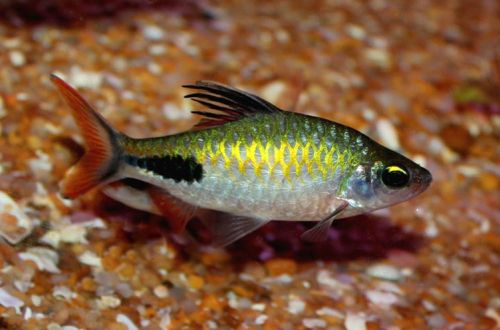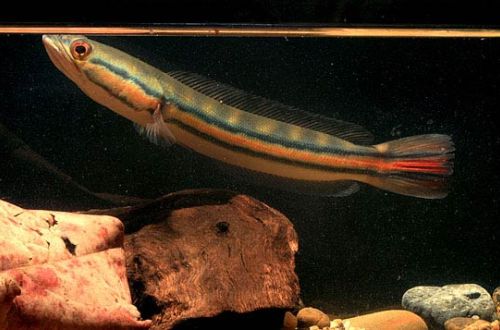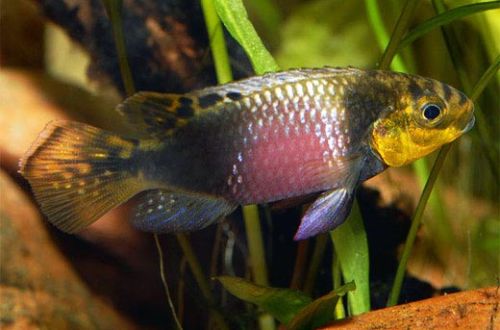
Barbus Rohana
The Rohan barb, scientific name Dawkinsia rohani, belongs to the family Cyprinidae (Cyprinidae). The fish is named after two freshwater fish biologists, Richard Dawkins and Rohan Petyagod. Easy to keep and breed, compatible with many other freshwater species, can be recommended for beginning aquarists.

Contents
Habitat
Occurs in southern India. It is considered an endemic species of the Tamiraparani river basin and its main tributaries Kodayar and Paraliyar. The rivers originate in the Western Ghats and drain into the Laccadive Sea. Fish are found mainly in mountainous areas of rivers. This type of terrain is characterized by rocky substrates, numerous snags and an abundance of coastal vegetation. The water level and its hydrochemical composition varies depending on the season.
Brief information:
- The volume of the aquarium – from 200 liters.
- Temperature – 19-25°C
- Value pH — 6.0–7.5
- Water hardness – 2–10 dGH
- Substrate type – any
- Lighting – any
- Brackish water – no
- Water movement – light or moderate
- The size of the fish is 8–9 cm.
- Food – any food
- Temperament – peaceful
- Keeping in a group of 8-10 individuals
Description
A close relative of Barbus Dawkins and Exclamation Barbus, which is expressed in the external similarity of these fish. Adults reach a length of about 9 cm. They are brightly colored. The upper part of the body has greenish shades from emerald green to light green, the belly is silvery. The anal and caudal fins are red. The dorsal fin is dark with filiform rays. There is a black stroke at the base of the tail. Sexual dimorphism is weakly expressed, clear differences appear during the spawning period – males have small growths on their heads in addition to a pink blush.
Food
Accepts most popular aquarium fish foods such as dry flakes, pellets, fresh, live or frozen brine shrimp, bloodworms. It is recommended to use food that stimulates the color of fish.
Maintenance and care, arrangement of the aquarium
Aquarium sizes for long-term maintenance should start at 200 liters, which is quite enough for a small flock of Rohan Barbs. Arrangement is arbitrary. However, the fish will look most harmonious in an aquarium that resembles a natural habitat – a river with a moderate current, with soil of variable size (sand, stones, boulders) and a few snags in the form of roots or tree branches. Plants are optional but welcome.
When keeping, it must be taken into account that the fish come from flowing water bodies, therefore they do not tolerate the accumulation of organic waste and need a high content of dissolved oxygen. Many tasks can be solved by a productive filtration system (purifies water, provides flow, etc.), however, several mandatory care procedures cannot be neglected. You should regularly clean the aquarium with a siphon, remove plaque from the walls and design elements, replace part of the water (30-50% of the volume) with fresh water weekly, carry out equipment maintenance, and maintain stable pH and dGH values.
Behavior and Compatibility
Peaceful schooling fish. It is advisable to purchase a group of at least 8-10 individuals. Compatible with other non-aggressive calm species of comparable size, able to live in similar conditions.
Breeding / breeding
Breeding is simple, fry can appear even in a common aquarium, but in this case their survival rate will be extremely low. During the mating season, females lay dozens of eggs, and males immediately fertilize them. The incubation period lasts 24-48 hours, after another day the fry begin to swim freely. Parental instincts are not developed, so immediately after spawning, adult fish can eat their own caviar. The same fate will await the emerging fry.
In order to preserve offspring, a separate tank with identical water conditions is used – a spawning aquarium, where fertilized eggs or surviving fry are placed. The set of equipment consists of a simple airlift filter with a sponge and a heater. Subdued lighting is recommended, so a separate light source is not required. The presence of the form does not matter.
Fish diseases
In a balanced aquarium ecosystem with species-specific conditions, diseases rarely occur. Often, diseases are caused by environmental degradation, contact with sick fish, and injuries. If this could not be avoided and the fish shows clear signs of illness, then medical treatment will be required. Read more about symptoms and treatments in the Aquarium Fish Diseases section.





